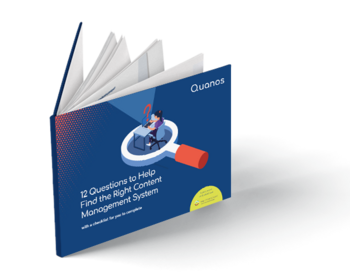Procedure
For content management systems, most implementation projects follow a typical sequence. First (1), the initial situation must be assessed, then (2) the potential for optimization must be identified. At this second stage at the latest, the economic analysis and thus the ROI also become important. Next (3), a target state must be defined and, finally (4), the system must be selected.
Several aspects must be considered in the initial situation (1). Of course, it is important to know which tools have been used up to now. However, the processes that are carried out in technical writing are at least as important. These are not only processes for creating the manual itself, but also, for example, processes for handling translations or creating evaluations. Finally, another aspect of analyzing the initial situation is how the existing tools and processes are integrated into the company's IT system. For example, is data retrieved from the PIM manually, via an Excel interface, or automatically?
When identifying potential areas for optimization (2), it is important to keep the entire situation in technical writing in mind. This means that all information products, all processes, all publications, all translations, and all automation should be examined for potential improvements. These optimization potentials must be weighed against the risks, e.g., what will happen to the documentation department in the short or medium term if a CMS is not implemented? Or: What resources or expertise are necessary for the changeover? The migration of existing data is also a source of risk.
ROI consideration
Quanos can support you in many ways when defining the target state (3), for example through contacts with reference customers, test installations, customer-specific supplier presentations, or consulting and training. This allows you to build up an accurate picture of how your editorial team wants to work in the future. Nothing stands in the way of system implementation. In fact, system implementation can be completed very quickly, especially if you opt for a standard system such as SCHEMA ST4 and do without special customizations. In most cases, only a few weeks separate system implementation and productive editorial work in the CMS.
So far, so simple! But how do you arrive at a cost-benefit estimate (2)? Well, the cost side is easy to determine because the system provider will tell you. You then compare this cost side with the savings you expect to achieve. Of course, you don't yet know exactly what savings can actually be realized in practice. That's why it makes sense to plan with an optimistic and a conservative scenario for the optimization estimates.
The metric for savings is the personnel costs you relate to working hours. You break down these savings into the most important activities in everyday documentational work, i.e., research, content creation, organizing translations, and layout tasks. For each activity block, estimates are made of the working hours to date and estimates for the work on these activity blocks with the CCMS. If you now plot the costs for the CCMS and the savings in activities on a monthly basis, you will obtain a diagram that allows you to clearly determine (and demonstrate) whether and when a ROI will be achieved.
Practical Experience
Where you can achieve savings with a CCMS naturally depends on your existing working environment and the other conditions in your technical documentation department. One area where there is typically a lot of room for optimization is the effort required for typesetting and layout (both for the source documents and in the various translations). Since the layout is generated automatically in a CCMS, the effort required here is close to zero. But many improvements can also be achieved in other activities, such as translation processing. For a system with five workstations and integrated workflows, the return on investment is typically achieved within nine to ten months. But regardless of when the ROI is actually realized, one thing is certain: it is always achieved in practice.
White Paper: 12 Questions to Help Find the Right Content Management System

Software manufacturers give interested parties many opportunities to get to know their content management systems, such as webinars or live demos. But which aspects deserve your special attention? And which issues are worth specific probing? We have put together twelve of the most important questions you should ask providers when you are choosing your new content management system.
At the end of this white paper, you will also find a checklist to complete, which will act as a useful guide in your discussions with providers.